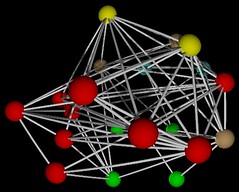 A very belated but sincere congratulations to Vice-President Al Gore and the IPCC team for being awarded the Nobel Prize. There is no more widely recognized signature of accomplishment and, in this case, it was very well deserved. (To those who may think otherwise, e.g. certain media pundits, I ask, "What have you done for me lately?")
A very belated but sincere congratulations to Vice-President Al Gore and the IPCC team for being awarded the Nobel Prize. There is no more widely recognized signature of accomplishment and, in this case, it was very well deserved. (To those who may think otherwise, e.g. certain media pundits, I ask, "What have you done for me lately?")
Okay, but down to the business at hand folks: models. Models lie at the heart of scientific work on climate change because of the desire to predict the future. A model capable of prediction requires two main components: data and mechanistic descriptions of Nature. Data about the real world in turn are needed for two reasons. First, they are the observations that lead to hypotheses of how things work. Second, they are used to test, and subsequently verify or modify or reject, those hypotheses. The hypotheses themselves are the mechanistic descriptions.
The final trick with climate models is to make them predictive. In other words, we want to use our past data, and our hypotheses, to gain a glimpse into what lies ahead. The big problem, and it's a huge one, is uncertainty. Everyone knows that the future is uncertain. The old Newtonian/Cartesian views of the Universe as machine are incorrect. To the best of our knowledge, randomness plays a part at all scales of reality, from the very small to the very large. Add quantum uncertainty to the uncertainties which grow from extreme sensitivity to small differences in intial conditions (e.g. chaos), as well as the uncertainty inherent in predicting the behaviour of complicated systems (e.g. humans), and we might feel that in Nature, all bets are off! But in the end, Nature is not entirely random; much of that randomness means that there are many possible roads ahead, and that it's often unclear as to which will be taken. To perhaps coin a cliche, An Inconvenient Truth has lead us to An Uncertain Future.
Models help us here, because these data-based, mechanistic descriptions of Nature allow us to aks "what if" questions. "What if the Greenland ice sheet collapses rapidly?" "What if the United States and China both lowered emissions from coal-fired power plants?" The questions which I like to ask are about the impacts of the answers to those "what if" questions. So let's just jump into our model, because there's no better way to learn and understand, than to simply do.
The question that we will address is: What is the predicted impact of changing [insert your favourite part of the environment here] on biological communities and ecosystems? To answer this, we will do 5 things:
- Build a basic, abstract model of a community.
- Modify the model to account for uncertainty in the observed data.
- Select community data from the fossil record. (I am, after all, a paleontologist)
- Hammer away at our model communities and see how they respond.
- Apply the model to modern communities.
We'll go through this process together in upcoming entries, and I would love to have your feedback (comments, questions, compliments, expressions of outrage, etc.). In the meantime, here's some reading (I will add these links shortly). Warning: the reading is technical in parts, but you can always do what many scientists do: read the Introduction, and Discusson/Conclusions, and leave the good bits alone!
Powered by ScribeFire.